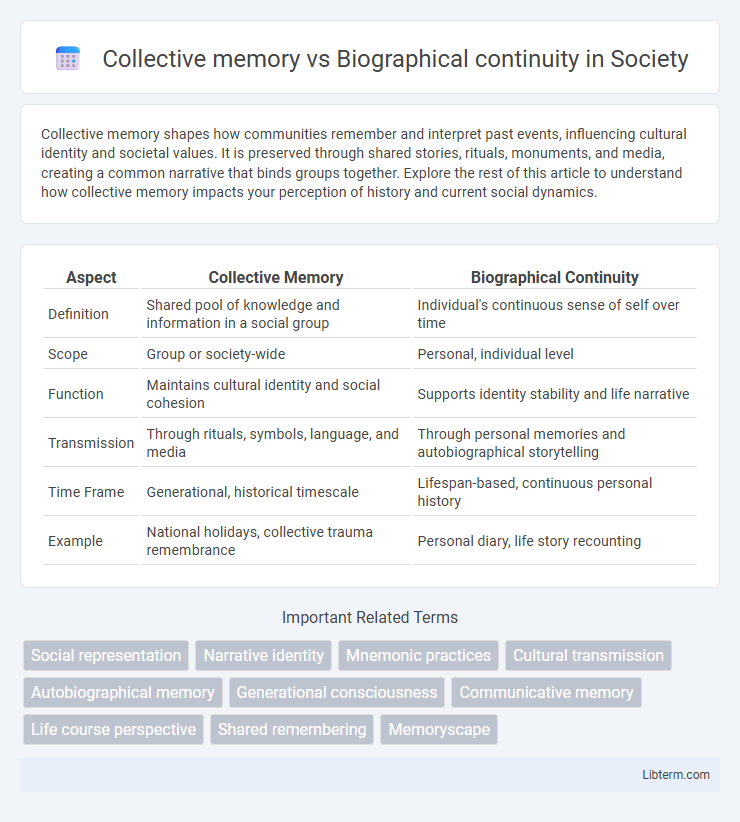Collective memory shapes how communities remember and interpret past events, influencing cultural identity and societal values. It is preserved through shared stories, rituals, monuments, and media, creating a common narrative that binds groups together. Explore the rest of this article to understand how collective memory impacts your perception of history and current social dynamics.
Table of Comparison
| Aspect | Collective Memory | Biographical Continuity |
|---|---|---|
| Definition | Shared pool of knowledge and information in a social group | Individual's continuous sense of self over time |
| Scope | Group or society-wide | Personal, individual level |
| Function | Maintains cultural identity and social cohesion | Supports identity stability and life narrative |
| Transmission | Through rituals, symbols, language, and media | Through personal memories and autobiographical storytelling |
| Time Frame | Generational, historical timescale | Lifespan-based, continuous personal history |
| Example | National holidays, collective trauma remembrance | Personal diary, life story recounting |
Understanding Collective Memory
Collective memory refers to the shared pool of knowledge and information held by a group, shaping a community's identity and cultural heritage over time. Understanding collective memory involves examining how societies construct and transmit narratives about past events, influencing present social norms and values. This contrasts with biographical continuity, which centers on an individual's personal memory linking past experiences to present identity.
Defining Biographical Continuity
Biographical continuity refers to the seamless integration of past personal experiences that shape an individual's sense of identity and provide a coherent narrative across their lifespan. It emphasizes the consistent connection between memories, values, and life events, enabling a stable self-concept despite transitions and changes. Unlike collective memory, which concerns shared societal recollections, biographical continuity centers on the unique, ongoing personal history that supports psychological well-being and identity coherence.
Historical Roots of Collective Memory
Collective memory originates from shared historical experiences and cultural narratives that shape a community's identity across generations. It differs from biographical continuity, which centers on an individual's personal history and life story continuity. The historical roots of collective memory lie in social practices, commemorations, and transmitted knowledge that foster communal bonds beyond individual lifespans.
The Role of Personal Narratives
Personal narratives play a crucial role in bridging collective memory and biographical continuity by anchoring shared historical events within individual experiences. These stories provide context and emotional resonance, linking societal pasts to personal identities. Emphasizing detailed recollections and subjective interpretations enriches collective memory, while maintaining a coherent sense of self over time.
Mechanisms of Memory Transmission
Collective memory is transmitted through rituals, storytelling, and cultural symbols that reinforce shared identities across generations, while biographical continuity relies on personal narratives and autobiographical recollections maintained within families or close social networks. Mechanisms such as oral histories, archival records, and commemorative practices serve to preserve collective memory, whereas diaries, photographs, and personal archives sustain biographical continuity. Both forms depend on repeated engagement and social validation to ensure the persistence and accuracy of memory over time.
Cultural Influences on Memory Formation
Collective memory shapes how societies remember shared events, deeply influenced by cultural narratives, rituals, and symbols that reinforce group identity over time. Biographical continuity relies on personal experiences and individual recollections, which are often framed and interpreted through culturally specific norms and values. Cultural influences guide the encoding, retention, and recall of memories by embedding individual and collective experiences within a broader sociocultural context.
Conflicts Between Collective and Individual Memory
Conflicts between collective memory and biographical continuity often arise when societal narratives overshadow or contradict an individual's lived experiences, leading to identity dissonance. Collective memory, shaped by communal rituals, media, and education, can impose selective interpretations that marginalize personal histories. This tension challenges individuals to reconcile public recollections with personal memories, influencing psychological well-being and historical understanding.
Social Identity and Memory Construction
Collective memory shapes social identity by creating shared narratives that bind groups through common experiences, while biographical continuity focuses on the individual's personal history continuity to maintain self-concept over time. Memory construction involves both collective and individual processes, where social frameworks influence the interpretation and transmission of memories, reinforcing group identity and personal coherence. The interplay between collective memory and biographical continuity highlights how social identity is negotiated through the dynamic reconstruction of past events within both personal and communal contexts.
Impact on Community and Individual Resilience
Collective memory strengthens community identity by preserving shared experiences, fostering social cohesion, and enabling collective problem-solving, which enhances community resilience. Biographical continuity supports individual resilience by maintaining a coherent sense of self over time, integrating past experiences into ongoing personal narratives that help individuals adapt to change. Together, these processes reinforce both community solidarity and personal stability, crucial for overcoming social crises and personal challenges.
Integrating Collective and Biographical Perspectives
Integrating collective memory and biographical continuity involves examining how personal life narratives intersect with shared cultural and historical experiences to shape identity formation. Collective memory provides a framework of social values and events that inform individual biographies, while biographical continuity allows personal experiences to contribute to the evolution of collective memory. This interplay enhances understanding of identity by linking individual memories with collective historical consciousness, fostering a comprehensive perspective on personal and communal identity development.
Collective memory Infographic

 libterm.com
libterm.com